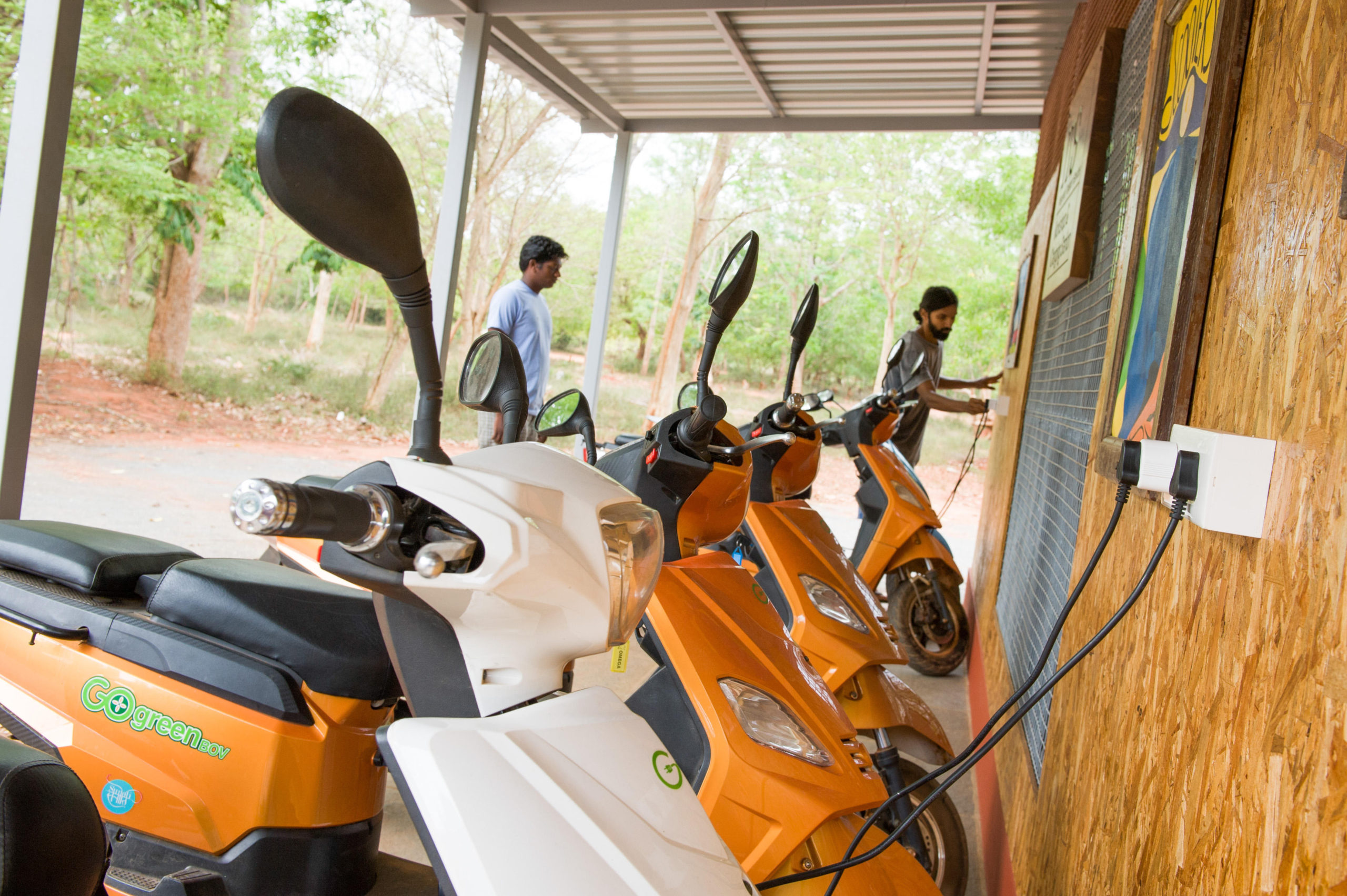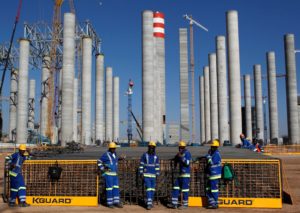Mahesh Joshi, 58, a Pune-based businessman, bought an electric Chetak for his wife eight months ago. The e-scooter soon became his own favourite ride. The overall impressive, hassle-free running of the scooter and sky-rocketing fuel prices have made his petrol-powered motorbike redundant. He is now anxiously waiting for the manufacturer Bajaj Auto to reopen bookings for the model so that he can buy another for himself.
Joshi is not alone. Noida-based Avinash Sharma bought an Okinawa I-Praise e-scooter a few months ago. Since then, his old motorcycle has been idling in the parking lot.
Satisfied customers like Joshi and Sharma are why many believe that India’s electric vehicle revolution might be led by two-wheelers. The running costs of e-scooters are only a tenth of those of internal combustion-powered two-wheelers, and a persistent rise in fuel prices is only widening this difference. Two wheelers also make up 81% of vehicles on India’s roads, and given that they are much cheaper, there is a shorter payback period than electric cars.
Tiny electric scooter market
Nevertheless, the current numbers are tiny. India sold 152,000 electric two-wheelers in 2019-20, up from 126,000 in 2018-19. This fiscal year has dampened the rise, as the Covid-19 pandemic has wreaked mayhem on the economy: a total of 143,821 electric two-wheelers were sold over the past year, a decline of 6% year-on-year, according to the Society of Manufacturers of Electric Vehicles (SMEV).
The federal government’s 2019 FAME (Faster Adoption and Manufacturing of Hybrid and Electric Vehicles) policy offered a subsidy of up to INR 150,000 (USD 2,000) per electric two-wheeler. This was supposed to encourage faster adoption of e-scooters and motorcycles, but only 25,700 high-speed scooters (with speeds above 42-45 kmph) were sold in 2020. For a market that sells 20 million two-wheelers per year, according to the Society of Indian Automobile Manufacturers, the conversion to electric two-wheelers is abysmal.
Rajiv Bajaj, managing director of Bajaj Auto, blames the introduction of low-speed, poor-quality products for the slow adoption of EVs. “When you introduce a new technology, it has to be aspirational. The reason why electric vehicles have not been profitable is not only because the battery cost is too high but because the products have not been aspirational enough,” said Bajaj.
When you introduce a new technology, it has to be aspirationalRajiv Bajaj, Bajaj Auto
Tarun Mehta, the co-founder of Indian electric vehicle company Ather Energy, seconds this: “The problem of EVs in India and globally has been a lack of good products. Tesla became a success not just because of subsidies but because the company figured a very successful, aspiring and an extraordinary [product] in Model S.”
Bajaj also believes the strategy adopted by some of the earlier entrants is flawed. “If you make an e-scooter at the price of an Activa (costing INR 81,000 or USD 1,083 on-road in Mumbai), you will not make money.”
Targeting the aspirational Indian
The e-scooter segment is now aiming higher. Ather, which is backed by the largest two-wheeler manufacturer in the world, Hero MotoCorp, launched its first e-scooter, the 450, in 2018. It cost INR 30,000 (USD 400) more than the Activa. Ather’s success encouraged legacy manufacturers like Bajaj and TVS already working on e-scooters to position themselves at the premium end of the market.
Bajaj launched its maiden offering under the Chetak brand in January 2020. The response to the model, with its retro-modern style, has attracted more buyers than Bajaj can cater to.
Others are also finding that there is a healthy demand. “We are getting a very good response from the market,” said Jeetendra Sharma, founder and managing director at Okinawa Autotech.
A massive potential market
Okinawa Autotech entered the market in 2017 and sells e-scooters under the I-Praise PraisePro and Ridge+ brands. It has sold over 90,000 units. Sharma believes that after a few years, electric two-wheelers will become a lot more viable due to the scale of production and will not need subsidies.
Although e-scooters and bikes cost more than those based on internal combustion engines, things are changing. Rising fuel prices and a reduction in lithium-ion battery prices, as well as subsidies offered by the federal and state governments, are narrowing the gap, Jinesh Gandhi, an analyst at financial services company Motilal Oswal, wrote in a recent research report. This has the potential to change the competitive landscape of the INR 340 billion (USD 4.55 billion) scooter segment, with a market size as large as around 5.6 million units, the report said.
Consultancy McKinsey estimated that the Indian e-two-wheeler market would hit 4.5-5 million in the 2025 financial year, accounting for 25-30% of the total market, and nine million by 2030 (around 40% of the total market).
Getting EV incentives right
Rajiv Bajaj says a city-based approach might show better results. “India can show the world a great example if the policymakers follow the mantra of narrowing the focus to a few cities and then have a target that after a decade there will be no internal-combustion engine vehicles,” he says. This will ensure participation even from global two-wheeler manufacturers who have so far stayed away from e-two-wheelers. “The country needs both [the] stick of policy and the carrot of incentives,” he said. The incentives and low Goods and Services Tax of 5% are good moves, but unless there is clarity over whether they are to be sustained, manufacturers may not go all out, said Bajaj.
Some, though, are taking the gamble already. In December last year, Bhavish Aggarwal, the founder of the ride-hailing company Ola, announced an investment of INR 24 billion (USD 321 million) to build a factory with a capacity of 10 million e-scooters by 2022. At full capacity this would be the equivalent of 20% of the global two-wheeler production capacity. His vision is to make India a hub in the production of urban mobility vehicles.
“We want to be world leaders in that,” he told Business Standard in a recent interview. “We believe we have a very unique opportunity to put India on the world map.”
Things are going to change dramatically for e-two wheelers in the next couple of yearsSohinder Gill, Hero Electric
Sohinder Gill, director-general of SMEV and chief executive of e-scooter company Hero Electric said: “Seeing the plans of all companies, particularly Ola Electric, it seems things are going to change dramatically for e-two-wheelers in the next couple of years marking an inflection point.” But Gill is less sure that the transformation will happen as quickly as Agarwal believes. “While he [Agarwal] believes it will happen by 2022, the rest of us believe it will take another seven to eight years for the market to reach that scale,” said Gill.
Policy hiccups
Gill’s company, Hero Electric, is the largest and oldest producer of e-two-wheelers in India, and it has suffered its share of setbacks. The FAME II policy linked incentives to local production, battery technology, acceleration and speed. Hero, like many others, made lead-acid powered low-speed products (with speeds below 40 kmph) and relied on imports. It was caught off guard. Out of 52,959 high-speed bikes sold since January 2019, only 31,813 vehicles were given subsidies under the FAME II scheme until December 2020 as the rest were disqualified.
The policy changes prompted Hero to revisit its lineup and align its products to new norms to avail itself of the scheme. In the fiscal year to date, Hero has sold 53,400 units, an increase of 13% over the past year, according to the company.
“We now have models that are not too dependent on subsidies. It will be a similar strategy even in the future,” said Gill, pointing out that before FAME II all models produced were subsidised, while now only 20% are subsidised. The average subsidy on the company’s products is INR 14,000 (USD 187), which is passed on to the customer in its entirety, he said.
EV makers are now waiting for the government to announce the third phase of the FAME policy, laying out a long-term roadmap to spur investment and inspire confidence. Manufacturers have been divided on the merits and demerits of the second one. Bajaj believes the earlier policy was flawed, and did not achieve the desired results, especially in making localisation mandatory. “It’s like putting the cart in front of the horse,” said Bajaj. “When a new technology is introduced in a market, the priority should be demand generation, as demand will drive scale and scale will lead to localisation.”
Others like Ather’s Mehta maintain that FAME II gave a clear direction to the industry, and it was only after the policy that there were some credible product launches like Chetak and iQube. “I don’t think it’s in the interest of the country to incentivise such policy [based in imports] after a decade of failure,” said Mehta.
In the end it will be buyers like Joshi and Sharma who will determine what policy works.


![Indians wearing protective masks stand with their luggage in queue outside a railway station [image: Alamy]](https://dialogue.earth/content/uploads/2020/05/indians-protective-masks-300x200.jpg)
![Phuentsholing Gas Station in Bhutan. Petrol stations create problems of emissions in a country too dependent on cars [image by: Omair Ahmad]](https://dialogue.earth/content/uploads/2020/01/Phuentsholing-Gas-Station-300x225.jpg)




![Indian father riding on at electric three wheeler with his child [image: Suman Kumar / Alamy]](https://dialogue.earth/content/uploads/2021/05/2BHEFB6-300x200.jpg)